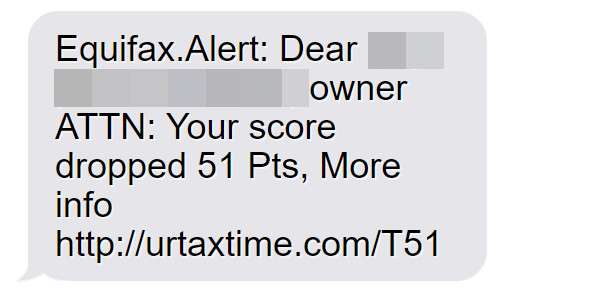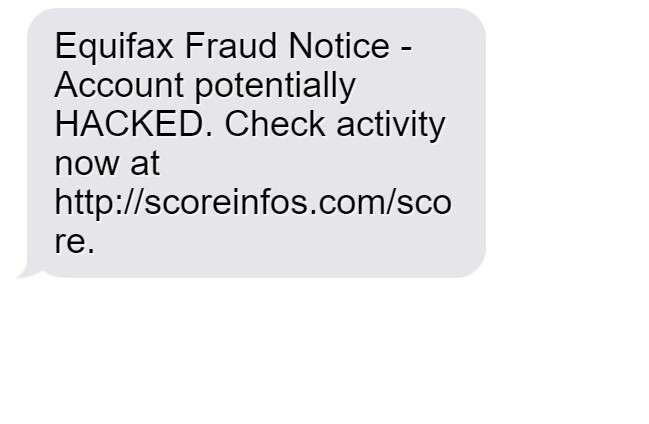Have you received a concerning text message from the number 1410200500 claiming to be Equifax and alleging an urgent issue with your credit score or account security? This is likely the latest version of the insidious Equifax Alert scam designed to trick recipients into giving up valuable personal information to fraudsters.
In this comprehensive guide, we will uncover how the 1410200500 Equifax Alert text message scam works, provide examples of the deceitful texts being sent from this number, explain the potential risks and damages if you fall victim, and offer advice on how to protect yourself from this identity theft tactic targeting consumers across the country.


This Article Contains:
Scam Overview
The 1410200500 Equifax Alert scam involves receiving a fraudulent text message that pretends to be from Equifax. The message comes from phone number 1410200500 and claims there is an immediate issue requiring your attention regarding your Equifax credit information or account.
Despite appearing to be from Equifax, these texts are phishing scams. They seek to urgently alarm recipients and trick them into clicking dangerous links.
Some examples of the deceitful scam texts sent from 1410200500 include:
- “Equifax Fraud Alert – Urgent security issue detected on your account. Click to verify identity: [malicious link]”
- “Equifax: We have detected unauthorized access to your account. Click below to verify identity and secure account: [malicious link]”
- “EMERGENCY ALERT: Equifax has detected compromised credentials associated with your account. REPLY NOW or account will be locked. [malicious link]”
The phishing links within these scam texts lead to fraudulent websites impersonating Equifax or other financial institutions. Unsuspecting users who click are deceived into providing personally identifiable information, exposing them to identity theft and further scams.
This scam spreads quickly through text message blasts, hoping recipients react hastily out of fear. However, Equifax warns consumers to be wary of any texts from 1410200500 alleging account or credit issues.
How the Scam Works
The 1410200500 Equifax Alert scam operates in several cunning steps designed to mislead victims and steal their information:
Step 1: Receiving the Text
The scam begins with the victim receiving an unsolicited text message from 1410200500. The message claims there is suspicious activity on your Equifax account that requires immediate attention.
It instills urgency and fear of threats like identity theft or credit damage. This motivates recipients to click the link without proper scrutiny. Some examples include:
- “Equifax Fraud Alert: We have detected unauthorized access on your account. Click below immediately to prevent identity theft: [malicious link]”
- “EMERGENCY from Equifax – Financial data breach has exposed your account credentials. Click to verify identity and prevent fraud: [malicious link]”
- “ALERT: Equifax has detected illegal activity associated with your account. REPLY NOW or account will be frozen permanently. [malicious link]”
Step 2: Visiting the Fake Site
If you click the link, it redirects to a sophisticated fake website mimicking Equifax’s login page. The site requests personal information to “verify your identity” and “regain access to your account.”
In reality, any data provided goes straight to scammers operating the fraudulent site. The realistic design convinces victims the site is legitimate.
Step 3: Personal Information is Stolen
Once you enter any sensitive information, like SSN, login credentials, or financial details, the scammers immediately gain access. They can now use your stolen data to commit identity theft.
Step 4: Account Access and Further Scams
Providing login information also grants scammers direct access to those accounts. They may continue accessing accounts even after stealing your initial data.
You’re also now vulnerable to additional scams, as criminals have your contact information and know you complied before.
Step 5: Credit Damage and Financial Risks
With your compromised personal information, scammers can inflict significant credit and financial damage through fraudulent accounts, charges, loan applications, and more. This can be challenging to detect and reverse.
The 1410200500 Equifax Alert scam thrives on imparting urgency and fear through seemingly credible texts. But no links from this number should ever be trusted regarding your financial accounts or data.
What to Do If You Have Fallen Victim
If you suspect you have fallen for the 1410200500 Equifax Alert scam, take these steps immediately:
Step 1: Stop Engaging with the Scammers
- Do not enter any more information on their sites
- Do not click any other links in texts from that number
- Block 1410200500 to prevent more scam texts
Step 2: Change Your Passwords
- If you shared login info, change those passwords immediately
- Enable two-factor authentication where possible
Step 3: Contact Relevant Institutions
- Notify your bank and credit card companies about compromised data
- Closely monitor accounts for fraudulent activity
- Consider requesting replacements for current cards/accounts
Step 4: Check Your Credit Reports
- Obtain copies of your credit reports from Equifax, Experian, and TransUnion
- Look for any suspicious new accounts or charges
- Place credit freezes with each bureau to block scammers
Step 5: Report the Scam Everywhere
- File reports about the scam with the FTC, FCC, and your local authorities
- Notify Equifax that their name is being used for fraud by 1410200500
- Submit complaints to any institutions where your data was compromised
Frequently Asked Questions about the 1410200500 Equifax Alert Scam
Consumers targeted by the fraudulent Equifax Alert text messages from 1410200500 often have many urgent questions. As an expert on this scam, I have provided answers below to some frequently asked questions to help protect you.
1. Why is 1410200500 linked to the Equifax Alert scam?
1410200500 is being used to send mass automated texts with this phishing scam. No legitimate texts from Equifax will ever originate from this number.
2. How do I know if a text from 1410200500 is fraudulent?
Any text from 1410200500 referencing Equifax, your credit information, or account security should be considered extremely suspicious and potentially part of this scam.
3. What are examples of the scam texts from 1410200500?
- “Equifax Fraud Alert – Our systems show your account was hacked. Call [malicious number] immediately to verify identity and secure account.”
- “EMERGENCY ALERT from Equifax – Financial data breach exposes your information. Click below to verify identity and prevent fraud: [malicious link]”
4. What happens if you click the link or call the number?
The phishing links and fake customer service numbers are designed to steal your personal information or expose you to additional scams. Do not interact with anything sent from 1410200500.
5. Should I call or text 1410200500 if I receive a message?
No, you should never respond to or interact with any texts from 1410200500 referencing Equifax or your accounts, as they are scams.
6. How can I report scam texts from 1410200500?
You can report them to the FTC, FCC, Equifax, and your mobile carrier. This helps identify active scam campaigns.
7. What are the risks if you provide information to 1410200500 scams?
If you provide sensitive information, scammers can steal your identity, access existing accounts, open fraudulent new accounts, and inflict significant financial damages.
8. What should I do if I already clicked a link or called a number?
Immediately change any compromised account passwords, freeze your credit, monitor your financial accounts closely for fraudulent activity, and consider reporting potential identity theft.
9. How can I protect myself from scams originating from 1410200500?
Never click links, provide information, or engage with any texts from 1410200500 referencing Equifax or your financial accounts. Block the number to prevent more texts.
10. Who can I contact if I have more questions about the 1410200500 Equifax scam?
You should contact the FTC, your state consumer protection office, or trusted credit monitoring services for guidance protecting yourself from this scam campaign.
The Bottom Line
The 1410200500 Equifax Alert scam aims to alarm recipients with texts alleging urgent account issues. However, Equifax warns they do NOT contact consumers this way. Any texts from 1410200500 should be considered fraudulent phishing attempts.
Do not click any links, provide any personal information, or even respond to texts from this number. Report the scam texts to help warn others of this active fraud campaign. With knowledge of their deceitful tactics, we can work together to combat this scam and protect innocent consumers.










